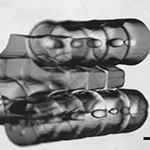Application of microtechnologies for the vascularization of engineered tissues
Main Article Content
Abstract
Recent advances in medicine and healthcare allow people to live longer, increasing the need for the number of organ transplants. However, the number of organ donors has not been able to meet the demand, resulting in an organ shortage. The field of tissue engineering has emerged to produce organs to overcome this limitation. While tissue engineering of connective tissues such as skin and blood vessels have currently reached clinical studies, more complex organs are still far away from commercial availability due to pending challenges with in vitroengineering of 3D tissues. One of the major limitations of engineering large tissue structures is cell death resulting from the inability of nutrients to diffuse across large distances inside a scaffold. This task, carried out by the vasculature inside the body, has largely been described as one of the foremost important challenges in engineering 3D tissues since it remains one of the key steps for both in vitroproduction of tissue engineered construct and the in vivointegration of a transplanted tissue. This short review highlights the important challenges for vascularization and control of the microcirculatory system within engineered tissues, with particular emphasis on the use of microfabrication approaches.
Article Details
How to Cite
GAUVIN, Robert et al.
Application of microtechnologies for the vascularization of engineered tissues.
Vascular Cell, [S.l.], v. 3, n. 1, p. 24, oct. 2011.
ISSN 2045-824X.
Available at: <https://vascularcell.com/index.php/vc/article/view/10.1186-2045-824X-3-24>. Date accessed: 01 jan. 2026.
doi: http://dx.doi.org/10.1186/2045-824X-3-24.
Section
Review

